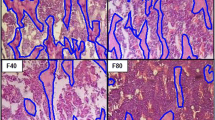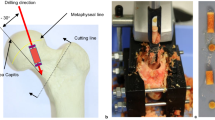Summary
The aim of the investigation was to measure the effect of fluoride on vertebral trabecular bone compressive strength and to correlate this with fluoride-induced changes in bone density. This correlation would express changes in the quality of bone during fluoride treatment. Pigs were used in the experiment because their trabecular bone structure and remodeling sequences are very similar to the human. Eight animals receiving a supplement of 2 mg F−/kg b.w. per day from age 8–14 months were compared with 8 control animals. Morphologic measurements in the animals receiving fluoride supplement showed a significant increase of 17% in bone density and a smaller, insignificant increase of 3% in ash weight analyses. Meanwhile, the mechanical parameters for the fluorotic animals were unchanged (maximum compressive strength, maximum stiffness, and energy-absorption capacity) or decreased (normalized compressive strength=maximum compressive load corrected for ash density). It is concluded that the increased bone mass during the initial stages of fluoride treatment does not necessarily indicate an improved bone quality. The discrepancy between bone mass and strength could be either a permanent or a temporary phenomenon and requires further investigation.
Similar content being viewed by others
References
Charles P, Mosekilde L, Taagehøj Jensen F (1985) The effects of sodium fluoride, calcium phosphate, and vitamin D2 for one to two years on calcium and phosphorous metabolism in postmenopausal women with spinal crush fracture osteoporosis. Bone 6:201–206
Jowsey J, Riggs BL, Kelly PJ, Hoffman DL (1972) Effect of combined therapy with sodium fluoride, vitamin D and calcium in osteoporosis. Am J Med 53:43–49
Briancon D, Meunier PJ (1981) Treatment of osteoporosis with fluoride, calcium, and vitamin-D. Orthop Clin North Am 12:629–48
Bernstein DS, Cohen P (1967) Use of sodium fluoride in the treatment of osteoporsis. J Clin Endocrinol Metab 27:197–210
Riggs BL, Hodgson SF, Hoffman DL, Kelly PJ, Johnson KA, Taves D (1980) Treatment of primary osteoporosis with fluoride and calcium. Clinical tolerance and fracture occurrence. JAMA 243:446–449
Parfitt AM (1982) Treatment of osteoporosis: theoretical possibilities. Clin Invest Med 5:181–183
Parfitt AM, Mathews CHE, Villanueva AR, Kleerekoper M, Frame B, Rao DS (1983) Relationships between surface, volume and thickness of iliac trabecular bone in aging and in osteoporosis. J Clin Invest 72:1396–1409
Kanis JA (1984) Treatment of osteoporotic fracture. Lancet 1:27–33
Kanis JA, Meunier PJ (1984) Should we use fluoride to treat osteoporosis? A review. Q J Med 53:210:145–164
Sharma YD (1982) Effect of sodium fluoride on collagen cross-link precursors. Toxicol Lett 10:97–100
Sharma YD (1982) Variations in the metabolism and maturation of collagen after fluoride ingestion. Biochem Biophys Acta 715:137–141
Gron P, McCann HG, Bernstein D (1966) Effect of fluoride on human osteoporotic bone mineral. J Bone Joint Surg 48A:892–898
Posner AS (1967) Relationship between diet and bone mineral ultrastructure. Fed Proc 26:6:1717–1722
Kragstrup J, Richards A, Fejerskov O (1984) Experimental osteo-fluorosis in the domestic pig. A histomorphometric study of vertebral trabecular bone. J Dent Res 63:6:885–889
Saville PD (1967) Water fluoridation: effect on bone fragility and skeletal calcium content in the rat. J Nutr 91:353–357
Nordenberg D, Simkin A, Gedalia I, Robin G (1971) The effect of sodium fluoride and sodium monofluorophosphate on the mechanical properties of normal and osteoporotic rat bone. Isr J Med Sci 7:529–531
Wolinsky I, Simkin A, Guggenheim K (1972) Effects of fluoride on metabolism and mechanical properties of rat bone. Am J Physiol 223:46–50
Chan MM, Rucker RB, Zeman F, Riggins RS (1973) Effects of fluoride on bone formation and strength in Japanese quail. J Nutr 103:1431–1440
Riggins RS, Zeman F, Moon D (1974) The effects of sodium fluoride on bone breaking strength. Calcif Tissue Res 14:283–289
Riggins RS, Rucker RC, Chan MM, Zeman F, Beljan JR (1976) The effect of fluoride supplementation on the strength of osteopenic bone. Clin Orthop 114:352–357
Mosekilde Li, Viidik A, Mosekilde Le (1985) Correlation between the compressive strength of iliac and vertebral trabecular bone in normal individuals. Bone 6:291–295
Carter DR, Hayes WC (1977) The compressive behavior of bone as a two-phase porous structure. J Bone Joint Surg 59-A:7:954–962
Stein ID, Granik G (1980) Human vertebral bone: relation of strength, porosity and mineralization to fluoride content. Calcif Tissue Int 32:189–194
Henrikson P, Lutwak L, Krook L, Skogerboe R, Kallfelz F, Belanger LF, Marier JR, Sheffy BE, Romanus B, Hirsch C (1970) Fluoride and nutritional osteoporosis: physicochemical data on bones from an experimental study in dogs. J Nutr 100:631–642
Oxlund H, Andreassen TT (1980) The roles of hyaluronic acid, collagen and elastin in the mechanical properties of connective tissues. J Anat 131:4:611–620
Lucas PA, Ophaug RH, Singer L (1984) The effect of vitamin A deficiency and fluoride on glycosaminoglycan metabolism in bone. Connect Tissue Res 13:17–26
Faccini JM (1969) Fluoride and bone. Calcif Tissue Res 3:1–16
Inkovaara J, Heikinheimo R, Jarvinen K, Kasurinen U, Hanhijarvi H, Iisalo E (1975) Prophylactic fluoride treatment and aged bones. Br Med J 3:73–74
Riggs BL, Seeman E, Hodgson SF, Taves DR, O'Fallon WM (1982) Effect of the fluoride/calcium regimen on vertebral fracture occurrence in postmenopausal osteoporosis. Comparison with conventional therapy. N Engl J Med 306:446–450
Parsons V, Mitchell CJ, Reeve J, Hesp R (1977) The use of sodium fluoride, vitamin D and calcium supplements in treatment of patients with axial osteoporosis. Calcif Tissue Res 22(Suppl):236–240
Author information
Authors and Affiliations
Rights and permissions
About this article
Cite this article
Mosekilde, L., Kragstrup, J. & Richards, A. Compressive strength, ash weight, and volume of vertebral trabecular bone in experimental fluorosis in pigs. Calcif Tissue Int 40, 318–322 (1987). https://doi.org/10.1007/BF02556693
Received:
Revised:
Issue Date:
DOI: https://doi.org/10.1007/BF02556693




